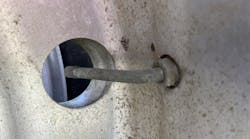When COVID-19 stopped most of the world just a few years ago, the trucking industry kept moving freight so people could survive and thrive. For a brief period, there was an outpouring of love and support for the essential employees who maintained the supply chain during the pandemic. The hardworking men and women who operate and maintain the trucks were deemed essential because even politicians knew what would happen if they stopped. A survey of truck drivers showed that at the height of the pandemic, 96% felt appreciated for what they do. But, just a couple of years later, only 67% did. How quickly we forget.
The world is full of unsung heroes, and even "Dirty Jobs" host Mike Rowe can't spotlight all the countless underappreciated jobs needed for society to function. Tires and wheels are no different, so I felt it was time to give some attention to the most underappreciated, overlooked and taken-for-granted component on the wheel end. This part is essential by every definition, and if it fails, all the technology in the world will not save the assembly from going flat.
It's time to put the valve stem in the spotlight, center stage.
For tubeless tire technology to function, there must be a way to inflate and deflate the tire. By placing a hole in the rim surface, installing a valve stem meets the inflation and deflation needs while maintaining the air pressure inside the tire. On a tubeless radial truck tire, the interface between the valve hole in the rim and the valve stem is a primary leak point. It's the Achilles' heel that will bring a tire to the ground if it cannot preserve the integrity of the inflation chamber.
Ultimately, a small piece of rubber or silicone creates a seal between the valve stem and the rim. A part that costs pennies can disable a $500 tire on a $300 wheel in no time. Valve stem leaks are painfully slow and can bleed out a few pounds of pressure each week. If drivers or maintenance people keep topping a tire off when necessary, then a small leak can go unnoticed for months. If the pressure is not checked or maintained regularly, it can lead to a belt separation after underinflation takes its toll on the tire casing.
See also: Tire Tracks: Eyes on TPMS, retreads, and telematics
There are two types of valve stem sealing mechanisms: the grommet and the O-ring. Most grommets are used on brass valve stems that are installed in steel rims. Standard grommets are rubber, but there are other grommets with compounds that can withstand high-heat applications. Brass valve stems can only be installed on steel wheels. Aluminum wheels use O-rings and grommets. Most standard low-profile 22.5-inch radial truck tires on aluminum wheels require "chrome-plated" valve stems that seal with an O-ring in the base. Wide base and other aluminum wheel applications use a grommet like the ones used on steel wheels. In either case, the O-ring or grommet is typically made of silicone.
Standard brass valve stems in steel wheels are incredibly durable. They rarely fail, but over time, the rubber in the grommet will start to deteriorate. If it dries out enough, the stem will begin to leak. The installation torque of 35 to 55 inch-pounds is important, but not critical. The grommet seals the valve hole on the top and the bottom, so the valve stem nut basically needs to be tight enough to seal the hole without damaging or severely deforming the rubber.
See also: Aperia receives $45M in growth funding from EnerTech
The aluminum wheel valve stem with an O-ring is a different story. The O-ring at the base is compressed on the inside of the rim to create an air-tight seal. The installation torque of 80 to 125 inch-pounds is critical because if the compression is insufficient, the valve will leak. But if the valve stem nut is over-torqued to the point where the O-ring is completely compressed and the base of the valve stem makes contact with the aluminum rim, corrosion can develop around the valve hole. Thus, a $5 part can destroy a $300 wheel if it's not installed correctly.
Tire and wheel manufacturers recommend replacing the valve stems or at least the sealing components when tires are changed. Fleets can be tempted to save a few dollars by passing on new valve stems, but the downside of ignoring these essential components can lead to higher tire costs, especially in operations with aluminum wheel assemblies.



